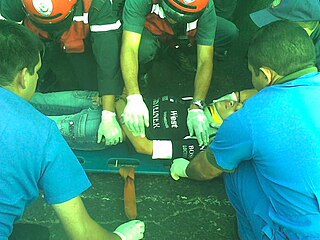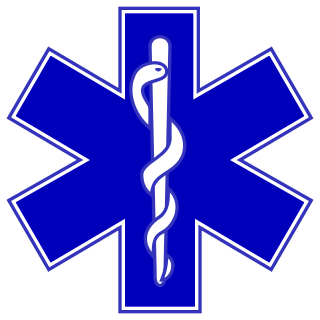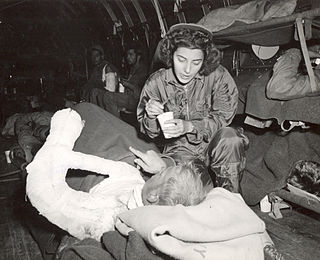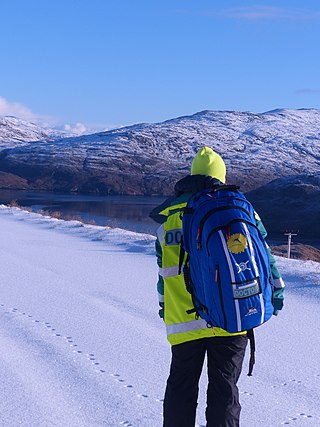
Emergency medical services (EMS), also known as ambulance services or paramedic services, are emergency services that provide urgent pre-hospital treatment and stabilisation for serious illness and injuries and transport to definitive care. They may also be known as a first aid squad, FAST squad, emergency squad, ambulance squad, ambulance corps, life squad or by other initialisms such as EMAS or EMARS.

Advanced cardiac life support, advanced cardiovascular life support (ACLS) refers to a set of clinical guidelines established by the American Heart Association (AHA) for the urgent and emergent treatment of life-threatening cardiovascular conditions that will cause or have caused cardiac arrest, using advanced medical procedures, medications, and techniques. ACLS expands on Basic Life Support (BLS) by adding recommendations on additional medication and advanced procedure use to the CPR guidelines that are fundamental and efficacious in BLS. ACLS is practiced by advanced medical providers including physicians, some nurses and paramedics; these providers are usually required to hold certifications in ACLS care.

An emergency department (ED), also known as an accident and emergency department (A&E), emergency room (ER), emergency ward (EW) or casualty department, is a medical treatment facility specializing in emergency medicine, the acute care of patients who present without prior appointment; either by their own means or by that of an ambulance. The emergency department is usually found in a hospital or other primary care center.

In emergency medicine, the golden hour is the period of time immediately after a traumatic injury during which there is the highest likelihood that prompt medical and surgical treatment will prevent death. While initially defined as an hour, the exact time period depends on the nature of the injury and can be more than or less than this duration. It is well established that the person's chances of survival are greatest if they receive care within a short period of time after a severe injury; however, there is no evidence to suggest that survival rates drop off after 60 minutes. Some have come to use the term to refer to the core principle of rapid intervention in trauma cases, rather than the narrow meaning of a critical one-hour time period.

Internal bleeding is a loss of blood from a blood vessel that collects inside the body, and is not usually visible from the outside. It can be a serious medical emergency but the extent of severity depends on bleeding rate and location of the bleeding. Severe internal bleeding into the chest, abdomen, pelvis, or thighs can cause hemorrhagic shock or death if proper medical treatment is not received quickly. Internal bleeding is a medical emergency and should be treated immediately by medical professionals.

Advanced Life Support (ALS) is a set of life saving protocols and skills that extend basic life support to further support the circulation and provide an open airway and adequate ventilation (breathing).

Advanced trauma life support (ATLS) is a training program for medical providers in the management of acute trauma cases, developed by the American College of Surgeons. Similar programs exist for immediate care providers such as paramedics. The program has been adopted worldwide in over 60 countries, sometimes under the name of Early Management of Severe Trauma, especially outside North America. Its goal is to teach a simplified and standardized approach to trauma patients. Originally designed for emergency situations where only one doctor and one nurse are present, ATLS is now widely accepted as the standard of care for initial assessment and treatment in trauma centers. The premise of the ATLS program is to treat the greatest threat to life first. It also advocates that the lack of a definitive diagnosis and a detailed history should not slow the application of indicated treatment for life-threatening injury, with the most time-critical interventions performed early.

In the United States, the paramedic is an allied health professional whose primary focus is to provide advanced emergency medical care for patients who access Emergency Medical Services (EMS). This individual possesses the complex knowledge and skills necessary to provide patient care and transportation. Paramedics function as part of a comprehensive EMS response under physician medical direction. Paramedics often serve in a prehospital role, responding to Public safety answering point (9-1-1) calls in an ambulance. The paramedic serves as the initial entry point into the health care system. A standard requirement for state licensure involves successful completion of a nationally accredited Paramedic program at the certificate or associate degree level.
Advanced Emergency Medical Technician - Critical Care (AEMT-CC) is a former Emergency Medical Services (EMS) certification that was unique to New York. The curriculum for AEMT-CC's in New York was similar to that of the national standard EMT-I/99 but with a broader scope of practice. EMT-CCs are fully classified as Advanced Life Support (ALS) providers within New York and are trained in advanced airway management, including intubation, IV fluid administration, cardiac monitoring, cardiac pacing, and both synchronized and unsynchronized cardioversion, and medication usage/administration in adult and pediatric patients.
Compassion fatigue is an evolving concept in the field of traumatology. The term has been used interchangeably with secondary traumatic stress (STS), which is sometimes simply described as the negative cost of caring. Secondary traumatic stress is the term commonly employed in academic literature, although recent assessments have identified certain distinctions between compassion fatigue and secondary traumatic stress (STS).

Emergency nursing is a specialty within the field of professional nursing focusing on the care of patients who require prompt medical attention to avoid long-term disability or death. In addition to addressing "true emergencies," emergency nurses increasingly care for people who are unwilling or unable to get primary medical care elsewhere and come to emergency departments for help. In fact, only a small percentage of emergency department (ED) patients have emergency conditions such as a stroke, heart attack or major trauma. Emergency nurses also tend to patients with acute alcohol and/or drug intoxication, psychiatric and behavioral problems and those who have been raped.
A flight paramedic is a paramedic who provides care to sick and injured patients in an aeromedical environment. Typically a flight paramedic works with a registered nurse, physician, respiratory therapist, or another paramedic. Flight paramedics must have an advanced medical knowledge along with years of clinical experience. Flight paramedics in the United States usually hold certifications such as the FP-C or the CCP-C, while in countries like the United Kingdom, they are typically required to hold a postgraduate certificate in critical care as a minimum, with many holding a master's degree in advanced practice or aeromedical critical care.

A flight nurse is a registered nurse specializing in the field of providing comprehensive pre-hospital, emergency critical care, and hospital care to a vast scope of patients. The care of these patients is generally provided during aeromedical evacuation or rescue operations aboard helicopters, propeller aircraft, or jet aircraft. On board a rescue aircraft, is a flight nurse, accompanied by flight medics and respiratory practitioners, as well as the option of a flight physician for comprehensive emergency and critical transport teams. The inclusion of a flight physician is more common in pediatric and neonatal transport teams. A critical care flight nurse must be able to deal with all age groups with broad critical emergencies. With no physicians on site, the nurses scope of practice is expanded. The critical care experience is transferred over to a flight nurse with impacting factors such as altitude and changes in pressure, gravitational forces, and weather. Some patients may experience exacerbations because of factors related to the cabin environment, including hypoxia, limited mobility, gas expansion, and the risk of injury related to turbulence. Resources for definitive care are limited. Aeromedical evacuation crews coordinate with other organizations to plan for the safe and timely care and evacuation of patients. Crews must be prepared for patients with trauma and mental health illnesses.
Grady straps are a specific strapping configuration used in full body spinal immobilization.
The Global Initiative for Emergency and Essential Surgical Care was established by the World Health Organization in December 2005. Its general purpose is to reduce "death and disability from road traffic accidents, trauma, burns, falls, pregnancy related complications, domestic violence, disasters and other emergency surgical conditions" by improving collaborations between relevant organizations, institutions, and agencies. Specific objectives include improving basic medical supplies at district hospitals, as well as better training for staff to bolster medical standards and care. Since its inception, GIEESC has grown to include over 2300 members from 140 countries which collaborates to share knowledge, advise policy formation and develop educational resources to reduce the burden of death and disability from conditions that could be treated through surgery.
Emergency medical services in Sri Lanka is being established using a public/private system aimed at the provision of emergency ambulance service, including emergency care and transportation to hospitals. The Pre-Hospital Care Committee is part of the Trauma Secretariat of the Sri Lanka Ministry of Healthcare and Nutrition and was established following the 2004 tsunami. The goal of the Pre-Hospital Care Sub-Committee is “During this generation and continuing for future generations, everyone in Sri Lanka will have access to trained pre-hospital medical personnel, ambulances are available to transport the sick and injured safely to hospitals, complications from harmful or inadequate pre-hospital care is eliminated so physician and nursing personnel at hospitals are delivered patients they are able to professionally treat and rehabilitate back to society as contributing citizens.” Pre-Hospital care is an essential, core component of trauma system.

Yellowknife Fire Division is a full-time fire department located in Yellowknife, Northwest Territories, Canada with full-time firefighters. The department was established in February 1943. Their staff consists of a fire chief, two deputy chiefs, and thirty-six full-time members, composed of four captains, four lieutenants and twenty-eight firefighters. They operate on a four-platoon system that consists of eight staff.

Pre-hospital emergency medicine, also referred to as pre-hospital care, immediate care, or emergency medical services medicine, is a medical subspecialty which focuses on caring for seriously ill or injured patients before they reach hospital, and during emergency transfer to hospital or between hospitals. It may be practised by physicians from various backgrounds such as anaesthesiology, emergency medicine, intensive care medicine and acute medicine, after they have completed initial training in their base specialty.












